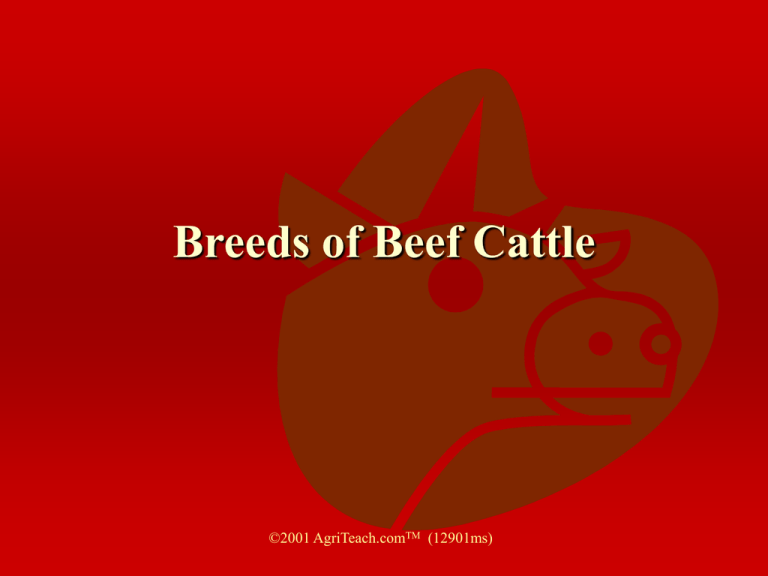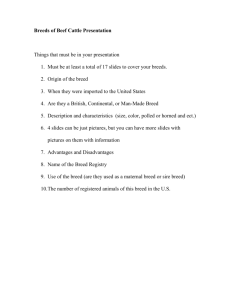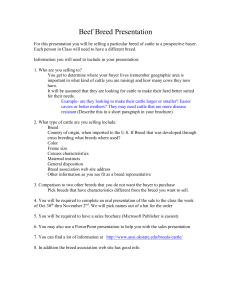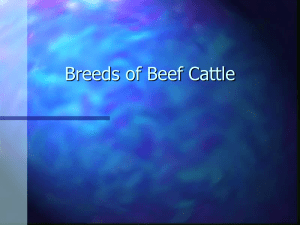Beef Breeds
advertisement

Breeds of Beef Cattle ©2001 AgriTeach.comTM (12901ms) The Beef Industry Produces 45% of all livestock cash receipts (‘92). An average person may consume 100 or more lbs. Of beef per year. Most beef eaten in the USA is raised in the USA. The state of Texas leads in the # of animals produced. Why raise beef? Cattle consume roughage & may graze pasture. Less labor than other industries, such as dairy. Useful in both large and small operations. Smaller initial capital investment. Development of Breeds Cattle, like most agricultural animals are bred. Most are the result of many generations of breeding. Most breeds were developed for a geographical area. Cattle with desirable characteristics are kept. Undesirable animals are no longer bred (culled). No breed has is perfect in all of its traits. No animal exhibits all of the perfect characteristics of its breed. Angus History: Originated from Scotland. Earliest records date to 1700. Imported to Kansas in 1873. Suited well to Midwestern climate. Today are found in every state in the USA. Breed Characteristics Black in color, smooth hair coat; also Red Angus Polled (naturally have no horns). Good carcass with well-marbled meat Angus Charolais History One of the oldest French breeds; central France. Imported to Mexico in 1930. Imported to Texas in 1936. Breed Characteristics White to light blonde in color, pink skin. Large and very well-muscled. Naturally horned. Bulls: 2,000-2,500 lbs.; cows: 1,500-1,800 lbs.. Charolais Chianina Pronounced “Kee-ah-nee-na” History Originated from Italy, one of the oldest in the world. Semen was imported to the USA in 1971. Breed Characteristics Black skin, originally white fur with black switch. BIG! Bulls - up to 4,000 lbs., 6 feet tall at withers. Cows - up to 2,400 lbs., 5 feet tall at withers. Improve growth rate if used in cross breeding. Chianina Hereford (horned & polled) History Originated in Hereford, England; polled in Iowa, 1901. First USA herd (horned) in New York in 1840. Horned registered since 1881. Breed Characteristics White faces with red, curled hair. Naturally horned. Very hardy and excellent foragers. White pattern is dominant in cross breeding. Hereford Polled Hereford Limousin History Originated in France 7,000 years ago. Breed Association formed in 1886. Semen imported to USA from Canada in 1968. Breed Characteristics Light yellow color with lighter circles around eyes. Light colored skin. Small head with short neck. Bulls - 2,400-2,000 lbs., Cows - 1,300 lbs.. Lean carcasses with large loin eye area. Limousin Shorthorn (polled and horned) History Originated in northern England, about 1600. Imported to Virginia in 1783. First herdbook in the USA. Breed Characteristics Red, White, or roan (mix of red and white) coat. Docile breed Bulls: up to 2,400 lbs.; cows: up to 1,500 lbs., Excellent milking capability. Shorthorn Shorthorn Brahman History Developed in southwestern USA. Closely related to Zebu, or Bos indicus cattle (India). Used mostly for crossbreeding. Breed Characteristics Characteristic “hump” over shoulder. Light or medium gray coat color. Large, drooping ears and loose skin. Brahman Brangus History A result of a cross of Brahman and Angus. Crosses made as early as 1912 in Louisiana. Red Brangus developed in Texas in 1946. Breed Description Solid black or red in color. Polled. Good mothering ability & feed efficiency. Brangus (Red) Texas Longhorn History Originated from cattle brought from Columbus. Cattle escaped and existed in the wild. Almost became extinct by 1900. USA congress funded a purebred herd. Breed Characteristics Many different colors and shadings. Horns spreading 4 feet or more. Are able to survive on sparse pasture. Texas Longhorn Simmental History Originated in Switzerland in the middle ages. Most popular breed in Europe. Brought to USA in 1969. Breed Characteristics With to light straw faces, with dark red bodies. Naturally horned. Docile Bulls: 2,300-2,600 lbs., cows: 1,400-1,800 lbs.. Simmental Other Breeds Devon Galloway Gelbvieh Maine Anjou Murray Grey South Devon Highland Belgian Blue Blonde d’Aquintaine





